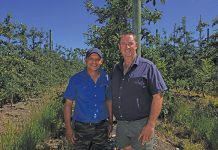
Photo: Bill Kerr
In years gone by, potato farming in South Africa was carried out mostly by smaller farmers, with only a few large producers. Today, it is done mainly by large operators.
This is due to the increased cost of labour, which has encouraged farmers to mechanise production, from planting to harvesting, and washing to packing. But to be able to afford this machinery, potato farmers must plant large areas.
Small-scale potato farmers are found largely in outlying areas, where mechanisation is confined to simple implements for removing the potatoes from the soil. Family members carry out the manual work.
READ Precision farming pays off for KZN potato producer
This is a very expensive crop to grow due to its high fertiliser requirement and the cost of seed potatoes. It’s risky to use potatoes from the market for planting; potential problems include introducing diseases to the soil and having viruses in the tubers that will ultimately result in a lower yield. To buy properly produced seed potatoes is like buying insurance.
Free of disease
Professionally produced seed potatoes start in a laboratory where plants are produced in vitro and tubers are grown under absolutely hygienic conditions for a few generations before becoming available as disease-free seed potatoes.
These are produced in cool areas, usually on isolated farms, and visited by inspectors who check that the crop is disease-free.
If you’ve produced a particularly healthy crop for the market, you can use the small tubers for planting with minimal risk. But you should do this only when there are no signs of virus in the crop and no aphids were seen during production. Keep in mind that a healthy crop can become contaminated by aphids migrating from a neighbour whose plants have a virus, and the damage will only be seen in the following crop.
READ Nature-friendly farming reduces costs for potato farmer
Potatoes do best in cool conditions. On the Highveld, the tubers are planted in late July/August, the timing depending on how advanced the sprouting development is. You don’t want them to be well emerged when there is danger of frost. If the shoots are just poking though the soil surface when frost hits, the damage will not be too severe. If you’re unsure, rather err on the side of caution.
If, however, you experience a late frost when the plants are about 20cm tall, the damage will be considerable. There’s not that much difference in harvest time between planting very early or when it’s safe to do so.
On the Highveld, you can plant up until January. In subtropical areas, April is a good time to plant. Years ago, having no experience of potatoes at all, I planted in early summer in
a subtropical area and was amazed at how healthy the crop looked. When it came time to harvest, however, there were almost no tubers. I learned a hard lesson!
There are generally fewer risks when planting in spring than in January. Conditions for blight are safer with early planting, and there’s also less chance of tuber moth damage.
When planting early, include an early variety as well, as the prices on the market are usually higher before Christmas.
Bill Kerr is a vegetable specialist and a breeder of a range of vegetables.
Articles of interest:












